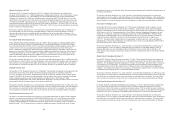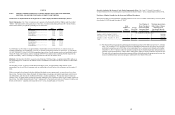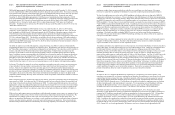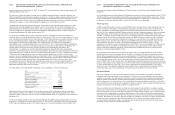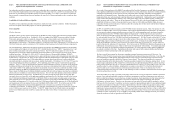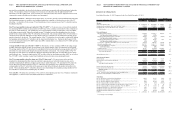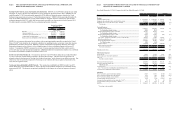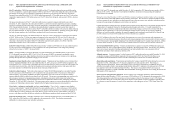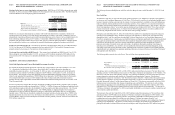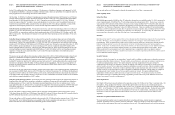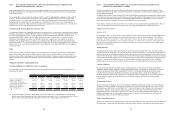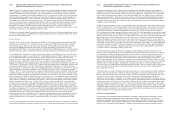Dish Network 2012 Annual Report Download - page 36
Download and view the complete annual report
Please find page 36 of the 2012 Dish Network annual report below. You can navigate through the pages in the report by either clicking on the pages listed below, or by using the keyword search tool below to find specific information within the annual report.Item 7. MANAGEMENT’S DISCUSSION AND ANALYSIS OF FINANCIAL CONDITION AND
RESULTS OF OPERATIONS - Continued
60
60
Our subscriber-specific investments to acquire new subscribers have a significant impact on our cash flow. While
fewer subscribers might translate into lower ongoing cash flow in the long-term, cash flow is actually aided, in the
short-term, by the reduction in subscriber-specific investment spending. As a result, a slow down in our business
due to external or internal factors does not introduce the same level of short-term liquidity risk as it might in other
industries.
Availability of Credit and Effect on Liquidity
The ability to raise capital has generally existed for us despite the weak economic conditions. Modest fluctuations
in the cost of capital will not likely impact our current operational plans.
Future Liquidity
Wireless Spectrum
On March 2, 2012, the FCC approved the transfer of 40 MHz of 2 GHz wireless spectrum licenses held by DBSD
North America and TerreStar to us. On March 9, 2012, we completed the DBSD Transaction and the TerreStar
Transaction, pursuant to which we acquired, among other things, certain satellite assets and wireless spectrum
licenses held by DBSD North America and TerreStar. The total consideration to acquire these assets was
approximately $2.860 billion. This amount includes $1.364 billion for the DBSD Transaction, $1.382 billion for the
TerreStar Transaction, and the net payment of $114 million to Sprint pursuant to the Sprint Settlement Agreement.
Our consolidated FCC applications for approval of the license transfers from DBSD North America and TerreStar
were accompanied by requests for waiver of the FCC’s Mobile Satellite Service (“MSS”) “integrated service” and
spare satellite requirements and various technical provisions. The FCC denied our requests for waiver of the
integrated service and spare satellite requirements but did not initially act on our request for waiver of the various
technical provisions. On March 21, 2012, the FCC released a Notice of Proposed Rule Making (“NPRM”)
proposing the elimination of the integrated service, spare satellite and various technical requirements attached to the
2 GHz licenses. On December 11, 2012, the FCC approved rules that eliminated these requirements and gave notice
of its proposed modification of our 2 GHz authorizations to, among other things, allow us to offer single-mode
terrestrial terminals to customers who do not desire satellite functionality. On February 15, 2013, the FCC issued an
order, which will become effective on March 7, 2013, modifying our 2 GHz licenses to add terrestrial operating
authority. The FCC’s order of modification has imposed certain limitations on the use of a portion of this spectrum,
including interference protections for other spectrum users and power and emission limits that we presently believe
could render 5 MHz of our uplink spectrum effectively unusable for terrestrial services and limit our ability to fully
utilize the remaining 15 MHz of our uplink spectrum for terrestrial services. These limitations could, among other
things, impact the finalization of technical standards associated with our wireless business, and may have a material
adverse effect on our ability to commercialize these licenses. The new rules also mandate certain interim and final
build-out requirements for the licenses. By March 2017, we must provide terrestrial signal coverage and offer
terrestrial service to at least 40% of the aggregate population represented by all of the areas covered by the licenses
(the “2 GHz Interim Build-out Requirement”). By March 2020, we must provide terrestrial signal coverage and
offer terrestrial service to at least 70% of the population in each area covered by an individual license (the “2 GHz
Final Build-out Requirement”). If we fail to meet the 2 GHz Interim Build-out Requirement, the 2 GHz Final Build-
out Requirement will be accelerated by one year, from March 2020 to March 2019. If we fail to meet the 2 GHz
Final Build-out Requirement, our terrestrial authorization for each license area in which we fail to meet the
requirement will terminate. In addition, the FCC is currently considering rules for a spectrum band that is adjacent
to our 2 GHz licenses, known as the “H Block.” If the FCC adopts rules for the H block that do not adequately
protect our 2 GHz licenses, there could be a material adverse effect on our ability to commercialize the 2 GHz
licenses.
Item 7. MANAGEMENT’S DISCUSSION AND ANALYSIS OF FINANCIAL CONDITION AND
RESULTS OF OPERATIONS - Continued
61
61
As a result of the completion of the DBSD Transaction and the TerreStar Transaction, we will likely be required to
make significant additional investments or partner with others to, among other things, finance the commercialization
and build-out requirements of these licenses and our integration efforts including compliance with regulations
applicable to the acquired licenses. Depending on the nature and scope of such commercialization, build-out, and
integration efforts, any such investment or partnership could vary significantly. Additionally, recent consolidation
in the wireless telecommunications industry, may, among other things, limit our available options, including our
ability to partner with others. There can be no assurance that we will be able to develop and implement a business
model that will realize a return on these spectrum licenses or that we will be able to profitably deploy the assets
represented by these spectrum licenses, which may affect the carrying value of these assets and our future financial
condition or results of operations.
In 2008, we paid $712 million to acquire certain 700 MHz wireless spectrum licenses, which were granted to us by
the FCC in February 2009. These licenses mandate certain interim and final build-out requirements. By June 2013,
we must provide signal coverage and offer service to at least 35% of the geographic area in each area covered by
each individual license (the “700 MHz Interim Build-out Requirement”). By the end of our license term (June
2019), we must provide signal coverage and offer service to at least 70% of the geographic area in each area covered
by each individual license (the “700 MHz Final Build-out Requirement”). We have recently notified the FCC of our
plans to commence signal coverage in select cities within certain of these areas, but we have not yet developed plans
for providing signal coverage and offering service in all of these areas. If we fail to meet the 700 MHz Interim
Build-out Requirement, the term of our licenses will be reduced, from June 2019 to June 2017, and we could face
possible fines and the reduction of license area(s). If we fail to meet the 700 MHz Final Build-out Requirement, our
authorization for each license area in which we fail to meet the requirement will terminate. To commercialize these
licenses and satisfy the associated FCC build-out requirements, we will be required to make significant additional
investments or partner with others. Depending on the nature and scope of such commercialization and build-out,
any such investment or partnership could vary significantly.
We have recently been engaged in discussions regarding a potential strategic transaction with Clearwire. On
January 8, 2013, Clearwire issued a press release summarizing the proposed transaction at that time. Later that day,
we confirmed that we had formally approached Clearwire with respect to a potential strategic transaction on the
terms and conditions generally outlined in Clearwire’s press release. The terms and conditions for a potential
strategic transaction at that time disclosed by Clearwire generally provided for the following, among others: (i) we
would acquire approximately 24% of Clearwire's total spectrum, for approximately $2.2 billion; and (ii) we would
make an offer to purchase up to all of Clearwire's outstanding shares at a price of $3.30 per share in cash. This offer
would be subject to certain conditions, including that we acquire no less than 25% of the fully-diluted shares of
Clearwire and receive certain governance and minority protection rights. There is no assurance that we will
continue discussions with Clearwire or that we will ultimately be able to conclude a transaction with Clearwire upon
the terms outlined above or at all.
To the extent that we are able to conclude a transaction with Clearwire, we may be required to commit a significant
portion of our cash and marketable securities to fund these arrangements, and these commitments may cause us to
defer or curtail investments in our core business, strategic investments, share repurchases or other transactions that
we otherwise may have made. Furthermore, Clearwire has experienced significant operating and financial
challenges in its recent history. Therefore, any investment we may make in Clearwire will be speculative, and we
may lose all of the investment. In addition, we may be required to spend additional capital or raise additional capital
to support an investment in Clearwire’s business and to build out a network to utilize the spectrum acquired, which
may not be available on acceptable terms or at all. There can be no assurance that we will be able to develop and
implement a business model that will realize a return on a possible transaction with Clearwire or that we will be able
to profitably deploy the spectrum assets, which may affect the carrying value of these assets and our future financial
condition or results of operations. If we are unable to successfully address these challenges and risks, our business,
financial condition or results of operations will likely suffer.






